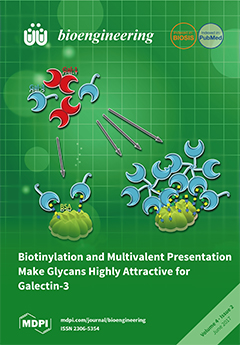Prevention and treatment of bleeding in patients suffering from hemophilia A are inconvenient due to repeated intravenous infusions owing to the short half-life of coagulation factor VIII (FVIII) in circulation. Besides (glyco-)pegylation of the FVIII molecule, a bioengineering approach comprises the protein fusion
[...] Read more.
Prevention and treatment of bleeding in patients suffering from hemophilia A are inconvenient due to repeated intravenous infusions owing to the short half-life of coagulation factor VIII (FVIII) in circulation. Besides (glyco-)pegylation of the FVIII molecule, a bioengineering approach comprises the protein fusion to Fc-immunoglobulin (Ig)G that mediate protection from clearance or degradation via binding to the neonatal Fc receptor. While human-like
N-glycosylation of recombinant FVIII is known to be crucial for the clotting factor’s quality and function, the particular glycosylation of the fused Fc portion has not been investigated in detail so far, despite its known impact on Fcγ receptor binding. Here, we analyzed the
N-glycosylation of the Fc part of a chimeric FVIII-Fc protein compared to a commercial IgG1 purified from human plasma. Fc parts from both samples were released by enzymatic cleavage and were subsequently separated via sodium dodecyl sulfate polyacrylamide gel electrophoresis (SDS-PAGE). Corresponding protein bands were referred to PNGase F in-gel digestion in order to release the respective
N-glycans. Analysis via matrix-assisted laser desorption/ionization time-of-flight (MALDI-TOF) mass spectrometry revealed structural differences of both
N-glycan patterns. Labeling with 2-aminobenzamide (2AB) and analysis via hydrophilic interaction liquid chromatography (HILIC) allowed a quantitative comparison of the respective
N-glycosylation. Observed variations in Fc glycosylation of the chimeric FVIII fusion protein and human plasma-derived IgG1, e.g., regarding terminal sialylation, are discussed, focusing on the impact of the clotting factor’s properties, most notably its binding to Fcγ receptors.
Full article






